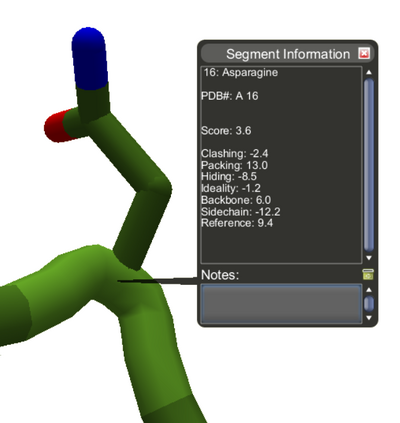
Segment information window showing segment number, total score, score parts, and subscores.
In Foldit, each segment of the protein has its own score. Score parts contribute to the score for a segment. The value of a specific score part is called a subscore.
The most important score parts are generally Clashing, Packing, Hiding, and Backbone.
You can see score parts and subscores by hovering the mouse over a segment and pressing the tab key to display the segment information window. Scores with a value of zero are not shown.
The recipe print protein 2.8 reports in detail on the subscores for all segments. Other recipes perform similar functions.
Score parts are calculated by the "Rosetta Energy Function". Foldit currently uses 2015 version of this function, known as REF2015.
The most prominent score parts are described in more detail below, including the REF2015 terms which contribute to each part.
Clashing[]
The clashing score part is related to clashes, which occur when atoms are too close to each other. If atoms are too close, their electron clouds repel each other, which destabilizes the protein.
REF2015 terms: fa_rep, fa_intra_rep
Packing[]
The packing score part reflects the extent that atoms are surrounded by other atoms. Packing is closely related to the idea of voids, spaces in the protein that aren't well packed. The combination of packing and clashing models the Van der Waals forces.
REF2015 terms: fa_atr
Hiding[]
The hiding score part is based on the hydrophobicity of the sidechain. In general, hydrophobic (orange) sidechains need to point inward, forming a hydrophobic core, while hydrophilic (blue) side chains need to point outward.
REF2015 terms: fa_sol, fa_intra_sol_xover4, lk_ball_wtd
Backbone[]
The backbone score part is based on the configuration of backbone atoms. The backbone score is directly affected by dihedral angles (see Dihedral angle, Rama Map).
REF2015 terms: rama_prepro, omega, p_aa_pp
Sidechain[]
The sidechain score part is derived from statistics which relate the shape of the sidechain to the shape of the backbone. A more negative score means that the configuration is rarer in nature, and thus less likely to be correct.
REF2015 terms: fa_dun
Disulfides[]
The disulfide score part is based the quality of a disulfide bridge. The disulfide score part is found only on cysteine segments.
REF2015 terms: dslf_fa13
Ideality[]
The ideality score part is based on how close the bond lengths, angles, and torsion angles of the peptide bonds between residues are to ideal values. Torsion angles depend on atoms of preceding and following residues, so the ideality subscores of neighboring residues affect each other.
REF2015 terms: cart_bonded, yhh_planarity
Bonding[]
The bonding score part is based on the hydrogen bonds between the segment and others.
REF2015 terms: hbond_sr_bb, hbond_lr_bb, hbond_bb_sc, hbond_sc
Density[]
The density score part is used on electron density puzzles, and shows how well a segment is covered by the electron density cloud.
The density score part is created by Foldit when an electron density cloud is present, and is not part of REF2015. Analogous functionality is available in Rosetta as an energy term.
Reference[]
The reference score part is the "reference energy" of each amino acid. Its main use is in design puzzles as a "normalization" factor, to correct for the bias for larger sidechains. (Larger sidechains are not necessarily more stable in nature.)
The reference score part can't be changed.
REF2015 terms: ref
Pairwise[]
The pairwise score part is based on the electrostatic energy of any charged but unbonded atoms with a certain distance of the atoms in a segment. This part models salt bridges and a number of other important protein structures.
Pairwise has begun appearing as a significant score part since Foldit upgraded to use REF2015 in early 2018. See the feedback Pairwise Segment Score? for further discussion.
REF2015 terms: fa_elec
Complete list[]
The score parts for a puzzle might include:
score part 1 = Clashing score part 2 = Pairwise score part 3 = Packing score part 4 = Hiding score part 5 = Bonding score part 6 = Ideality score part 7 = Other Bonding score part 8 = Backbone score part 9 = Sidechain score part 10 = Disulfides score part 11 = Reference score part 12 = Structure score part 13 = Holes score part 14 = Surface Area score part 15 = Interchain Docking score part 16 = Neighbor Vector score part 17 = Symmetry score part 18 = Van der Waals score part 19 = Density score part 20 = Other
Many of these score parts are not active in any current Foldit puzzles.
Useful links[]
- Density map scoring documentation in Rosetta: there are two density scores, not sure which one is used by Foldit.
- Energy Terms in Rosetta, for explanation on what each of these weirdly-named terms do